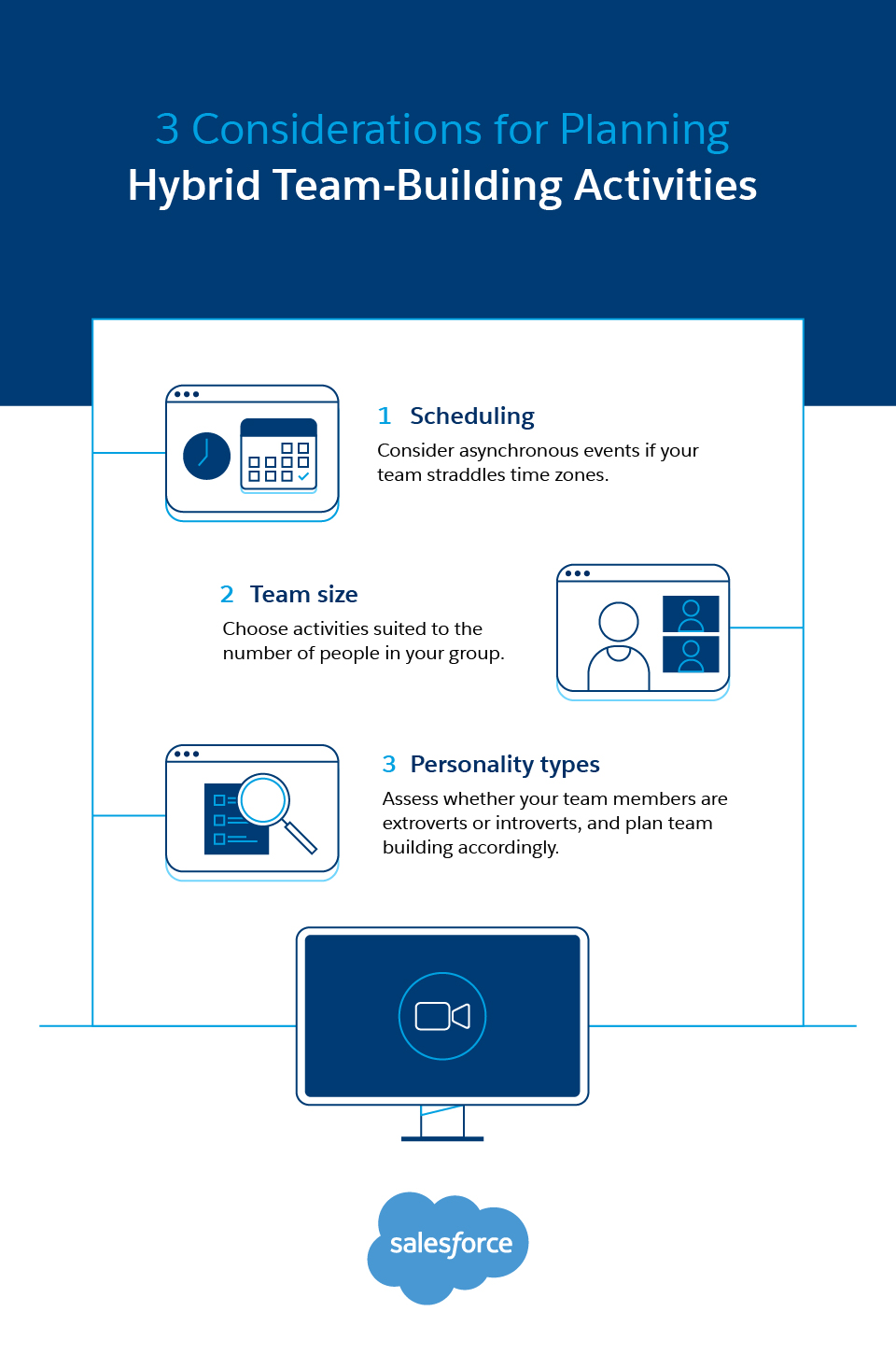Remote and hybrid teams are the new normal for many companies. More than four in 10 (43 per cent) SMBs surveyed in Salesforce’s Small and Medium Business Trends Report offer remote or hybrid work — and plan to do so for the long term.
Flexible working arrangements offer big benefits. Companies can lower their facility costs, and employees may be able to achieve a greater work-life balance. But remote and hybrid work can make it more challenging to build close-knit teams, especially as new hires join your company.
Managing hybrid employees may require a fresh mindset and new skills. Here’s how to choose the right team-building technique for your hybrid or virtual team.
Team Building in a Hybrid Work World
Team building may feel like one of your greatest challenges, even if you excel at bringing teams together in person. Simple questions like timing team-building activities or deciding how often to meet require extra consideration. Keep these factors in mind as you weigh your options.
Scheduling: Plan team-building events during work hours — and adjust your team’s workload accordingly. If your team straddles time zones and it’s not possible for everyone to participate at the same time, choose asynchronous activities.
Team size: A team of five will have different needs than a team of 50, so adjust your team-building activities accordingly. Some activities work best with small groups, so consider breaking your reports into smaller, competitive teams — or choose an activity that’s suited to large groups.
Personality types: Hybrid work challenges employees in different ways. Introverts may feel more drained after team building while extroverts may crave more activities. If you’re not sure about your team members’ personality types, ask during your one-to-one meetings. Then scale events up or down to suit your team — or be flexible about participation for mixed teams.

Setting Team Building Goals
As the hybrid work era becomes the new normal, it’s the perfect time to re-evaluate your team-building needs. Before creating a new team-building strategy, evaluate where your team is and what kind of team building would serve them best. Every team is different, so this step is important. Implementing the wrong strategy could drive away great employees or attract poor ones.
Team-building goals
Let’s explore the goals you may want to achieve with team building, then we’ll dig into some activity ideas.

Fostering communication: Out of the four main communication styles, assertive (but not aggressive) communication leads to respect and effective collaboration among teams. Activities that foster communication help your workers better understand how they interact without the pressure of a company project on the line.
Bonding: Psychological safety at work can contribute to increased engagement, improved recruitment and retention, reduced absenteeism, and more. When Google researched what makes an effective team, they put psychological safety at the top of the list. Team building aimed at helping employees build strong personal relationships with each other is a great way to build more psychological safety at work.
Problem solving: You likely solve problems for your business and customers each day. But being able to solve problems as a team requires a different skillset than tackling them alone. Activities that involve working together to achieve a non-work-related goal can help employees learn how to tackle problems together.
Sharing values: Nearly two-thirds (61 percent) of job candidates choose their employer based on their own values and beliefs. That means jobseekers factor in a company’s mission and values when weighing offers. Team-building activities are a great way to share your company’s values and bring them into employees’ everyday interactions and decisions.
Building skills: Sometimes your employees need to cross train or diversify skillsets among the team to ensure flexibility and agility. Both teaching and learning from colleagues helps elevate the team as a whole and trains employees to lean on each other’s expertise.
Team-Building Techniques for Hybrid Workers
Now that you understand goals for team building, it’s time to plan team-building activities to achieve them. Here are five techniques that may help your team bond.
1. Virtual escape rooms
Goals: Bonding, problem solving, building skills, fostering communication
Scheduling: Synchronous
Team Size: Small
Personalities: Extroverts
Have you ever wanted to lock your team in a room until they learn how to cooperate? A virtual escape room sets up a scenario for your team and encourages them to work together to solve puzzles within a time limit. Escape rooms check a lot of team building boxes in a single afternoon. Plus, they're fun! Worldwide, you can find more than 5,000 branded escape rooms. While these escape rooms require in-person interaction, virtual options give your team the same benefits without anyone needing to hop on a plane.
2. Activity kits
Goals: Bonding, sharing values, building skills
Scheduling: Synchronous
Team Size: Large or small
Personalities: Extroverts and introverts
Sometimes, breaking through the virtual barrier with tactical activities can help teams bond, build skills, and share company values with tangible results. If you can mail packages to your direct reports, you can use activity kits to help your team get to know each other. Whether your team’s into crafting, soap-making, house plants, or wine and cheese, you can find a kit that reflects your corporate values and brings everyone together — and you may even be able to help your team build some new skills.
3. Personality quizzes
Goals: Bonding, fostering communication
Scheduling: Synchronous or asynchronous
Team Size: Large or small
Personalities: Extroverts and introverts
Most people enjoy learning about themselves. Sharing those learnings can be a great way for employees to get to know each other, understand varied perspectives, and tailor their communication styles with different people.
Myers Briggs is a classic test, while My Personality Test and Enneagram are also great choices. Help your team learn about their varied work styles, or just have some fun with the Harry Potter Sorting Hat. Whichever test you choose, encourage your team to share their results and reactions with their co-workers by hosting a live reveal video call.

4. Lunch and learns
Goals: Building skills, fostering communication, bonding
Scheduling: Synchronous
Team Size: Large or small
Personalities: Extroverts
Lunch and learns are just what they sound like: Employees attend a meeting during lunch to learn something new. When done well, these events can help employees develop new skills, communicate better, and get to know each other. To get the most out of a lunch and learn:
Make it optional. Some workers may not want to add a lunch meeting to their day, and that’s okay. Lunch and learns work best when the attendees (and presenters) are excited and fully present.
Invite employees to teach. Not only will attendees learn something new, but the host will develop their own presentation and communication skills.
Keep it short. Keep the activity to 30 minutes and reserve the rest of the hour for an optional lunchroom chat.
Invite the occasional outside expert. If employees want to learn a particular skill but no one on your team has that knowledge, invite a colleague or professional speaker to present.
Don’t overdo it. Daily or even weekly lunch and learns can be overwhelming, so consider keeping it to once a month and then adjust up or down as you get feedback.
5. Virtual volunteering
Goals: Sharing values, bonding
Scheduling: Synchronous or asynchronous
Team Size: Large or small
Personalities: Extroverts and introverts
Volunteering as a team is a great way to bond while living your company values, but finding the right activity for a virtual or hybrid workforce can be challenging. The best activities can be done as a group while aligning with your company’s or team’s mission. For example, if you’re a marketing manager, consider using some of your team’s bandwidth to help a charity revamp its website. Or facilitate a mentoring program to help junior professionals or kids get career advice from industry professionals.
Whatever activity you choose, support your employees by giving them company time and supplies to participate.
6. Virtual scavenger hunts
Goals: Problem solving, fostering communication, bonding
Scheduling: Synchronous or asynchronous
Team Size: Large or small
Personalities: Extroverts and introverts
In-person scavenger hunts are classic team-building activities, and you can get the same benefits on a virtual or hybrid team too with a few tweaks. The key is to work together as a team (or break out into competitive sub-teams) so employees get to work together and be creative.
Design prompts around things everyone on your team has access to. Have your team hunt for photo ops at home, Google creatively, or capture live moments with Zoom video recordings or screenshots. Finally, reserve time at the end of the activity for teams to share their finds in a slideshow or via an online whiteboard tool.
The Bottom Line
Hybrid work is here to stay, and managers need new strategies for team building that account for the combination of a remote and in-office workforce. Creating bonds among your team is more than possible with a hybrid workforce. However, a ping-pong table in the break room and regular outings can’t bring your team together as they do for in-person employees. If a hybrid workforce is your new normal, take the time to analyze your team’s team-building needs and build an intentional program to address them with hybrid-friendly activities.


